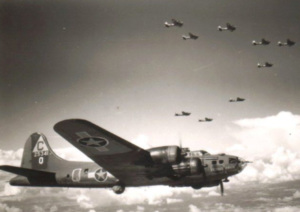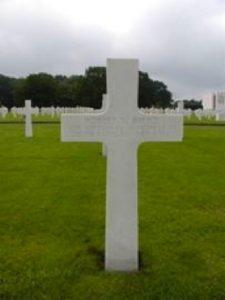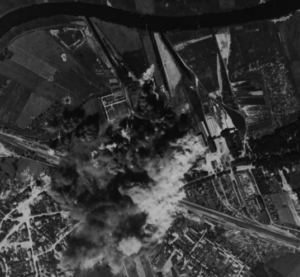Scroll of Honor – Robert Vines Bruce
A Victory of Sorts
Robert Vines Bruce attended Clemson College during the 1941-42 academic year, having already graduated from Boys’ High School and Anderson College in his hometown of Anderson. He was pursuing a pre-medicine course of study, intending to follow in the footsteps of his father, older brother and sister, each of whom was a doctor.
Bruce was called to active duty in March 1942 and was commissioned after Air Corps training. Bruce completed bombardier training and, in August 1943, shipped overseas. He was assigned to the 427th Bomb Squadron of the 303rd Bomb Group stationed at Molesworth, England.
The 303rd had arrived at Molesworth in Cambridgeshire north of London in November of the previous year, while Bruce was still in training. Beginning that month, the Group would go on to fly 364 missions, more than any other Eighth Air Force B-17 Group during World War II.
Bruce arrived in England during a period in which historian Donald Miller writes “casualties began to rise alarmingly.” The Eighth Air Force’s losses meant that newly arriving airmen and aircraft were being used “as replacements for decimated groups” rather than forming the basis of new combat formations.1
On October 9, 1943, Bruce’s crew, led by pilot Second Lieutenant Bernard Clifford, was alerted for a mission deep into Germany. On what was a busy day for the Eighth Air Force at that point in the war, 378 heavy bombers were dispatched to bomb four targets, two in Germany and two in Poland. Bruce’s aircraft was part of a one hundred fifteen

A B-17 of the 303rd Bomb Group in formation
plane force targeting the Arado Flugzeugwerke at Anklam on Germany’s Baltic Sea coast. The factory produced wings and tail sections for Germany’s FW-190 fighters, the very aircraft that would soon figure so prominently in the fate of Bruce and his crew.
The bomber crews were awakened in time to breakfast at 0320 hours. The early start was necessary to be able to make the 1,190 nautical mile trip during the daylight hours of the shortening autumn day. The 303rd was the lead group flying at a relatively low formation of 13,000 feet. It was the fourth combat mission for Bruce and the rest of the crew.
The heavy bombers delivered their payloads, dropping high explosive and incendiary bombs on the aircraft factory and then turned back toward England.
Around midday, Bruce’s aircraft was attacked by three FW-190 fighters flying three abreast. Rounds from the fighters’ 20 mm cannons hit the B-17, nicknamed “Son.” With its number three engine on fire and its propeller feathered, “Son” lost contact with the bomber formation at an altitude of 8,000 feet. It had lowered its landing gear, a signal to its attackers that it was no longer able to fight. At this sign, the German fighters withdrew.
But, the damage was done. The big bomber sank lower and lower, the frigid waters of the Baltic Sea coming closer and closer. The B-17 crashed into the sea at approximately 1220 hours near Lolland, Denmark. All ten members of the crew were killed.
the Baltic Sea coming closer and closer. The B-17 crashed into the sea at approximately 1220 hours near Lolland, Denmark. All ten members of the crew were killed.
Over a month later, on November 13, Bruce’s body was found on the beach at Dazendorfer Strand in Holstein, Germany. He was laid to rest in Heiligenhafen Cemetery two days later. After the war, Bruce’s remains were reinterred in the Ardennes American Cemetery in Neupre, Belgium. Bruce was awarded the Purple Heart. He was survived by his mother, his brother and six sisters.

Strike photos hint at the devastation afflicted at Anklam
The Arado plant and approximately 80% of the surrounding town were destroyed. As a result, fabrication of parts for Focke-Wulf, Junkers and Messerschmitt aircraft were dispersed to other areas. The mission for which Robert Vines Bruce and the other nine members of his crew had given their lives was considered a victory.
For more information about Second Lieutenant Robert Vines Bruce see:
https://cualumni.clemson.edu/page.aspx?pid=1818
For additional information on Clemson University’s Scroll of Honor visit: https://soh.alumni.clemson.edu/scroll-of-honor/
- Donald L. Miller, Masters of the Air: America’s Bomber Boys Who Fought The Air War Against Nazi Germany, (New York: Simon & Schuster Paperbacks, 2006), 167.
